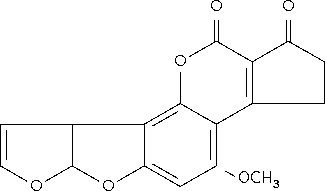Aflatoxin
|
|

Aflatoxins are naturally occurring mycotoxins that are produced by many species of Aspergillus; but most notably Aspergillus flavus and Aspergillus parasiticus. Aflatoxins are toxic and carcinogenic to both animals (such as rodents and sheep) and humans. After entering the body, aflatoxins are metabolized by the liver to an intermediate reactive, aflatoxin M1, an epoxide.
| Contents |
Contamination Conditions
Aspergillus is common and widespread in nature and are most often found when crops are exposed to a high humidity environment over a long period of time or are damaged in stressful conditions such as drought, a condition which lowers the barrier to entry.
The native habitat of Aspergillus is in soil, decaying vegetation, hay, and grains undergoing microbiological deterioration and it invades all types of organic substrates whenever and wherever the conditions are favorable for its growth. Favorable conditions include high moisture content (at least 7%) and high temperature.
Crops which are frequently affected include cereals (maize, sorghum, pearl millet, rice, wheat), oilseeds (peanut, soybean, sunflower, cotton), spices (chiles, black pepper, coriander, turmeric, zinger), and tree nuts (almond, pistachio, walnut, coconut).
The toxin can also be found in the milk of animals which are fed contaminated feed.
Pathology
High-level aflatoxin exposure produces an acute necrosis, cirrhosis, and carcinoma of the liver exhibited by hemorrhage, acute liver damage, edema, alteration in digestion, and absorption and/or metabolism of nutrients.
No animal species is immune to the acute toxic effects of aflatoxins including humans; however, humans have an extraordinarily high tolerance for aflatoxin exposure and rarely succumb to acute aflatoxicosis.
Chronic, subclinical exposure does not lead to as dramatic of symptoms as acute aflatoxicosis. Children, however, are particularly affected by aflatoxin exposure which leads to stunted growth and delayed development.
Long term, low-level exposure to aflatoxins leads to liver cirrhosis, failure and hepatocellular carcinoma.
Detection of Aflatoxin in Humans
There are two techniques that have been used most often to detect levels of aflatoxin in humans.
The first method is measuring the AFM1-guanine adduct in the urine of subjects. Presence of this breakdown product indicates exposure to aflatoxin in the past 24 hours. However, this technique has a significant flaw in that it only produces a positive result in approximately one-third of positive test subjects. Additionally, due to the half-life of this metabolite, the level of AFM1-guanine measured can vary significantly from day to day, based on diet, and thus is not useful for assessing long terms exposure.
Another technique, which has been used is a measurement of the AFM1 - albuminadduct level in the blood serum. This approach is significantly more accurate, as positive results are generated in 90% of positive test subjects. This test is also useful for measuring long-term exposure, as it remains positive for two to three months.
Major types of Aflatoxins and its metabolite
At least 13 different types of aflatoxin are produced in nature. Aflatoxin B1 is considered the most toxic and is produced by both Aspergillus flavus and Aspergillus parasiticus. Aflatoxin G1 and G1 are produced exclusively by A. parasiticus. While the presence of Aspergillus in food products does not always indicate harmful levels of aflatoxin are also present, it does imply a significant risk in consumption of that product.
- Aflatoxin B1 & B2 : produced by Aspergillus flavus and A. parasiticus.
- Aflatoxin G1 & G2 : produced by Aspergillus parasiticus.
- Aflatoxin M1 : metabolite of Aflatoxin B1 in humans and animals (exposure in ng can come from mother's milk).
- Aflatoxicol.
Interaction of Aflatoxin with Hepatitis B Virus
Studies have shown that concurrent infection with Hepatitis B virus (HBV) during aflatoxin exposure increases the risk of hepatocellular carcinoma (HCC). As HBV interferes with the ability of hepatocytes to metabolize aflatoxins, an aflatoxin M1-DNA conjugate exists for a longer period of time in the liver, increasing the probability of damage to oncogenes such as p53. This effect is synergistic with the resulting damage far greater than just the sum of aflatoxin or HBV individually. (Williams, 2004)
Decreasing HBV infection levels through vaccination is an effective and simple approach that can be taken to reduce these harmful synergistic effects, thus decreasing the impact of chronic aflatoxin exposure. This strategy may prove to be highly effective – many regions of the world which have high aflatoxin rates, such as western Africa and China, also have high HBV infection rates.
References
- Williams, Jonathan, H, et al. (2004) “Human aflatoxicosis in developing countries: a review of toxicology, exposure, potential health consequences, and interventions.” The American journal of clinical nutrition 80 (5), 1106-1122.
External links
- Carcinogenicity of aflatoxins (IARC) (http://monographs.iarc.fr/htdocs/monographs/vol82/82-04.html)de:Aflatoxin
